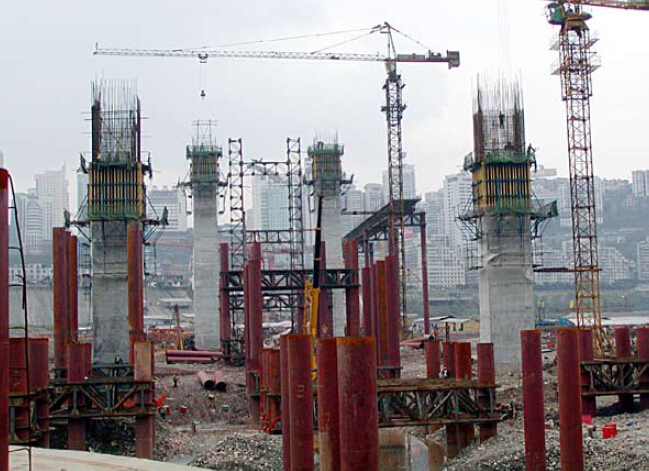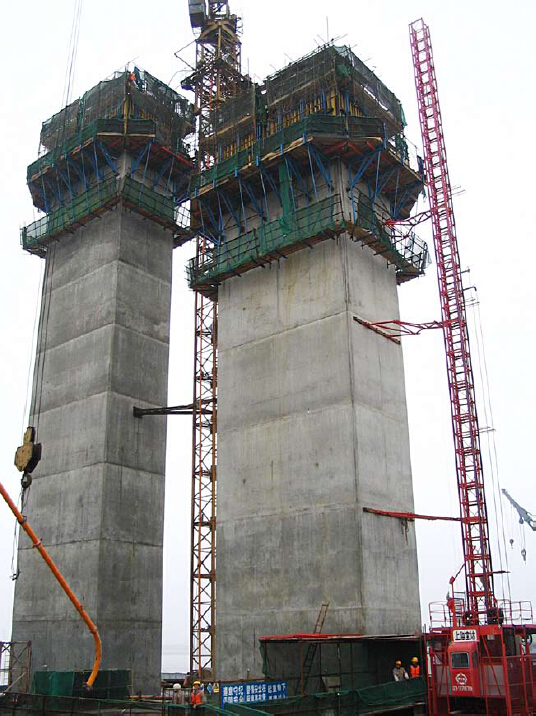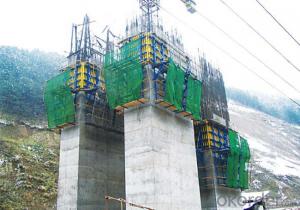Climbing Bracket CB240 for formwork and scaffolding system
- Loading Port:
- Tianjin
- Payment Terms:
- TT OR LC
- Min Order Qty:
- 50 m²
- Supply Capability:
- 1000 m²/month
OKorder Service Pledge
OKorder Financial Service
You Might Also Like
Climbing Bracket CB240 & CB210
They are framework brackets for supporting large-area wall formwork.
Typical applications for the CB240&CB210 are pier and column/shear wall/core walll/ in the
building.
CB210 has smaller size than CB240, it will be cost effective in some condition.
Characteristics:
◆ High bearing capacity
The high loading capacity of the brackets allow very large scaffold units. This saves the number
anchor points required as well as reducing climbing times.
◆ Simple moving procedure by crane
Through the strong connection of formwork together with the climbing scaffold, both can be moved
as a single climbing unit by crane. Thus valuable time-savings can be achieved.
◆ Fast striking process without a crane
With the retrusive set, large formwork elements can also be retracted quickly and a minimum of
effort.
◆ Safe with work platform
The platforms have assembled firmly with bracket and will be climbing together, without scaffolding
but can work safely in spite of your high location.


- Q:How is steel formwork supported during concrete pouring?
- Steel formwork is supported during concrete pouring by using props or scaffolding. These supports are strategically placed at regular intervals to provide stability and prevent any sagging or movement of the formwork. Additionally, adjustable bolts or wedges are used to ensure that the formwork remains level and in the desired position throughout the pouring process.
- Q:What are the different types of form ties used in steel formwork?
- Steel formwork utilizes various types of form ties, each serving specific purposes and meeting distinct requirements. 1. Coil Ties: Flexibility and effortless installation and removal are provided by coil ties, which feature a coil rod with two to four coils. These ties are commonly utilized in lighter applications where lower pressure is anticipated. 2. Flat Ties: Constructed from steel, flat ties possess wide, flat plates on both ends. Their purpose is to connect opposing wall forms, ensuring stability and preventing bulging or spreading caused by concrete pressure. 3. She-Bolt Ties: She-bolt ties consist of a she-bolt attached to one end of a threaded rod. These ties secure wall forms together, and the threaded rod allows for easy formwork adjustment. 4. Snap Ties: Snap ties are a popular choice for swift and efficient formwork installation. They consist of a metal rod with a button-like head on one end and a wedge on the other. By inserting the button head into the formwork and driving the wedge into the button head using a hammer, a robust connection is created. 5. Cone Ties: Similar to snap ties, cone ties possess a cone-shaped head instead of a button head. The cone head is inserted into the formwork, and a metal wedge is driven into the cone, securing the formwork. 6. Waler Ties: Waler ties connect horizontal waler beams with vertical formwork members, enhancing the strength and stability of the formwork system. 7. Loop Ties: Made of steel wire, loop ties feature loops on both ends. They are employed to fasten wall forms together and can be effortlessly removed once the concrete has cured. 8. Pin and Wedge Ties: Pin and wedge ties comprise a pin and a wedge. The pin is inserted into the formwork, and the wedge is driven into the pin, creating a tight and secure connection. These examples represent only a fraction of the form ties available for steel formwork. The selection of a tie depends on factors such as construction type, desired strength, ease of installation, and specific project requirements.
- Q:How does steel formwork handle different concrete surface protection methods?
- Steel formwork is a versatile and durable option for constructing concrete structures, and it can easily handle different concrete surface protection methods. The formwork itself is typically made of steel plates or frames that provide a strong and rigid support structure for the wet concrete. When it comes to protecting the concrete surface, there are various methods that can be employed, such as applying surface coatings, using form release agents, or using various types of form liners. Steel formwork can easily accommodate these methods and ensure their effectiveness. For instance, if a surface coating is being applied to protect the concrete, steel formwork can provide a smooth and uniform surface that allows for even and consistent application of the coating. The steel formwork is resistant to damage from the coating materials and can withstand the pressure and weight of the wet concrete while the coating cures. Similarly, when using form release agents, steel formwork can ensure proper adhesion and prevent any sticking or bonding between the concrete and the formwork. The smooth and non-porous surface of steel formwork allows for easy application and removal of the form release agents, ensuring a clean and protected concrete surface. Furthermore, steel formwork can accommodate the use of various types of form liners, which are used to create decorative or textured finishes on the concrete surface. The form liners can be easily attached to the steel formwork to create the desired texture or pattern, and the sturdy nature of steel ensures that the form liners remain securely in place during the pouring and curing process. In summary, steel formwork is highly compatible with different concrete surface protection methods. Its strength, durability, and versatility allow for easy application of coatings, form release agents, and form liners, ensuring a well-protected and aesthetically pleasing concrete surface.
- Q:Can steel formwork be used in airport or transportation infrastructure projects?
- Yes, steel formwork can be used in airport or transportation infrastructure projects. Steel formwork is a versatile and durable option for construction projects, including those in the airport and transportation sectors. It offers several benefits such as high load-bearing capacity, ease of assembly and disassembly, and the ability to withstand harsh weather conditions and heavy usage. Steel formwork also provides excellent dimensional accuracy, ensuring precise and consistent results. Additionally, it can be easily reused, making it a cost-effective choice for large-scale projects like airports and transportation infrastructure. Overall, steel formwork is a suitable and efficient solution for constructing various elements in airport or transportation projects, such as foundations, columns, beams, and slabs.
- Q:How does steel formwork affect the overall cost of concrete construction?
- Steel formwork can increase the overall cost of concrete construction due to its higher initial investment compared to other formwork materials. However, it offers several advantages such as durability, reusability, and better quality finishes, which can result in cost savings in the long run by reducing the need for frequent replacements and rework. Additionally, steel formwork allows for faster construction and improved productivity, which can offset the initial cost by reducing labor expenses and project timelines.
- Q:How does steel formwork affect the overall thermal insulation of a structure?
- Steel formwork does not have a direct impact on the thermal insulation of a structure as it is primarily used for shaping and supporting concrete during construction. The primary purpose of steel formwork is to provide structural stability and shape to the concrete elements of a building, such as walls, slabs, and columns. The overall thermal insulation of a structure is mainly determined by other factors such as the type and thickness of insulation materials used, the design of the building envelope, and the presence of thermal bridges. Insulation materials such as foam boards, fiberglass, or mineral wool are typically installed within the walls, floors, and roofs to limit heat transfer through conduction, convection, and radiation. While steel formwork itself does not contribute significantly to thermal insulation, it can indirectly affect the insulation of a structure through its impact on the construction process. For instance, if the steel formwork is not properly sealed or installed, it can create gaps or voids in the concrete, which may allow heat to escape or enter the building. Additionally, if the formwork is not aligned accurately, it can affect the placement of insulation materials, resulting in thermal bridging and reduced overall insulation effectiveness. It is crucial to ensure that proper insulation measures are taken during the construction process, regardless of the type of formwork used. This includes ensuring that insulation materials are correctly installed without any gaps or thermal bridges and that the formwork is properly sealed to prevent air leakage. By addressing these aspects, the thermal insulation of the structure can be effectively maintained, regardless of the presence of steel formwork.
- Q:Can steel formwork be used for marine construction projects?
- Yes, steel formwork can be used for marine construction projects. Steel has excellent strength and durability, making it suitable for withstanding the harsh marine environment. It offers stability and resistance to corrosion, making it a reliable choice for constructing structures in or near the water.
- Q:What are the common types of connections used in steel formwork systems?
- Steel formwork systems utilize various types of connections, including wedge connections, pin and wedge connections, bolted connections, clamped connections, and magnetic connections. Wedge connections involve employing a wedge-shaped device to firmly secure the panels together. The wedge is inserted into a slot and tightened, creating a dependable and robust connection. Pin and wedge connections entail using pins and wedges to connect the formwork panels. The pins are inserted through panel holes, and the wedges are then driven into the pins, effectively locking them in position. Bolted connections utilize bolts to connect the formwork panels. Pre-drilled holes are present in the panels, and bolts are inserted through these holes and tightened with nuts. This connection method allows for effortless disassembly and reassembly of the formwork system. Clamped connections employ clamps made of steel to connect the formwork panels. These clamps are tightened using bolts or screws, resulting in a secure and rigid joint between the panels. Magnetic connections rely on magnets to connect the formwork panels. Magnetic strips or plates are embedded in the panels, and when the panels are brought close together, the magnets attract and hold them in place. While this connection method is quick and easy, it may not possess the same strength as other connection methods. Each of these connection types offers distinct advantages and disadvantages. The selection of a connection method depends on various factors, including project requirements, ease of assembly and disassembly, as well as the desired strength and stability of the formwork system.
- Q:How does steel formwork handle concrete curing compounds and sealers?
- Steel formwork is highly resistant to concrete curing compounds and sealers. Due to its non-porous surface, steel formwork prevents the penetration of these chemicals, ensuring that they do not interfere with the curing process or affect the quality of the concrete. Additionally, steel formwork is easy to clean and maintain, allowing for efficient removal of any residual compounds or sealers that may come into contact with it during construction.
- Q:How does steel formwork affect the overall construction site dust control?
- Steel formwork can significantly improve dust control on a construction site. Its solid structure and smooth surface minimize the release of dust particles, reducing the potential for airborne dust. Additionally, steel formwork can be easily cleaned and maintained, further limiting dust accumulation. Overall, using steel formwork helps create a cleaner and healthier environment for workers and minimizes the need for additional dust control measures.
1. Manufacturer Overview |
|
|---|---|
| Location | |
| Year Established | |
| Annual Output Value | |
| Main Markets | |
| Company Certifications | |
2. Manufacturer Certificates |
|
|---|---|
| a) Certification Name | |
| Range | |
| Reference | |
| Validity Period | |
3. Manufacturer Capability |
|
|---|---|
| a)Trade Capacity | |
| Nearest Port | |
| Export Percentage | |
| No.of Employees in Trade Department | |
| Language Spoken: | |
| b)Factory Information | |
| Factory Size: | |
| No. of Production Lines | |
| Contract Manufacturing | |
| Product Price Range | |
Send your message to us
Climbing Bracket CB240 for formwork and scaffolding system
- Loading Port:
- Tianjin
- Payment Terms:
- TT OR LC
- Min Order Qty:
- 50 m²
- Supply Capability:
- 1000 m²/month
OKorder Service Pledge
OKorder Financial Service
Similar products
New products
Hot products























